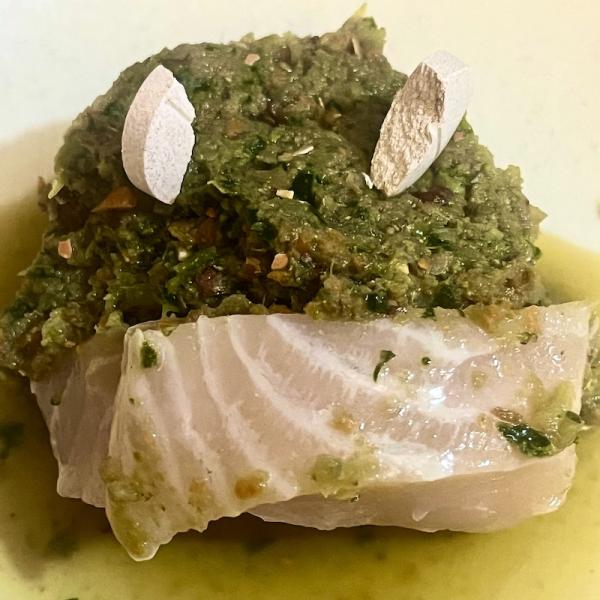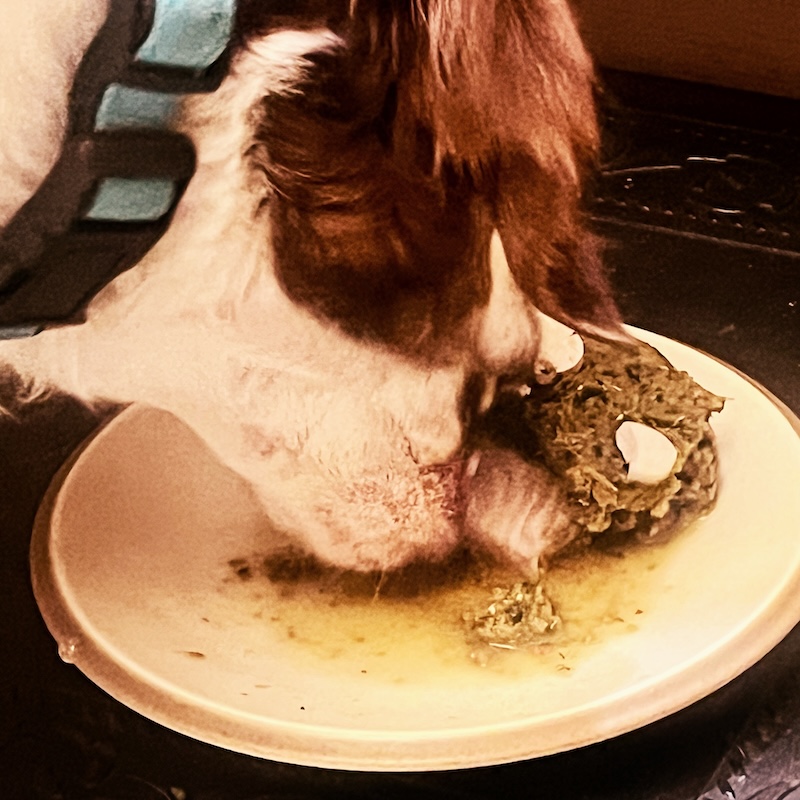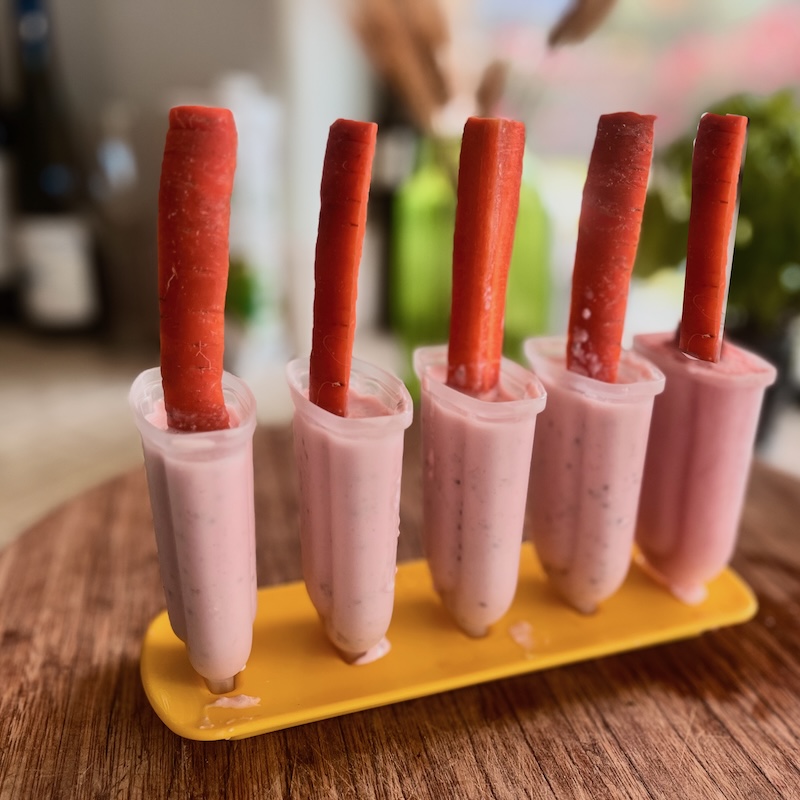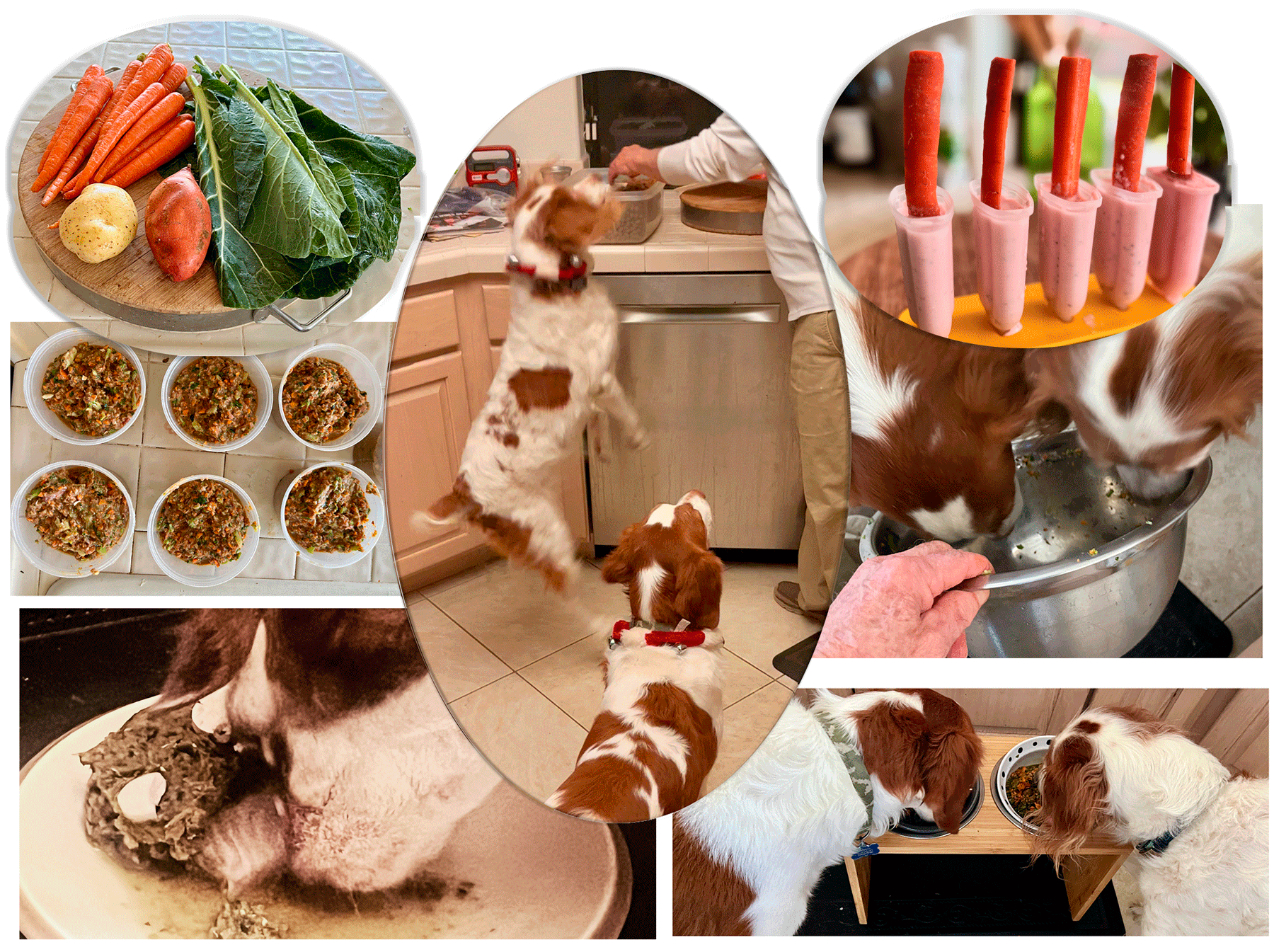In today’s environment, the original diet has been compromised. Here’s how to fix it and make it even better.
In my Spring 2023 article, The Happy Healthy Doggy, I explored how wild canines survive on less-than-fresh meals—like days-old roadkill—and introduced the BARF (Bones and Raw Food) diet as a safe, natural option for our Brittanys. But times have changed, and Raw isn’t automatically safe anymore.
Why? … Avian Influenza (Bird Flu).
Avian Influenza is spreading fast. While wild dogs avoid infected flocks by not raiding chicken coops, our pets rely on us for their food—often sourced from farms battling outbreaks. Chickens are culled quickly, and their eggs are discarded or washed. But who knows how long those precautions will last?
Beef poses an even more considerable risk. Dairy herds have tested positive in California and elsewhere. Experts fear a possible jump to humans. Cats are highly susceptible, raising concerns for dogs too. Keeping our pups safe isn’t just about love – it’s about protecting our homes.
So, how do wild dogs eat spoiled meat and live to bark about it?

Wild dogs aren't exactly master hunters—they're more like opportunistic snackers. Unless they're in a pack, they'll often let others (or even passing cars) do their hard work. Then they swoop in like sneaky dinner guests, claiming their prize… even if that prize has been marinating on the roadside for four or five days. Yum, right?
"Wait," you might be thinking, "wouldn't that be crawling with bacteria?" Absolutely! But here's the wild trick: their stomach fluids are super acidic, almost like nature's disinfectant. This acidic environment makes quick work of any nasty pathogen. Fun fact: humans are encouraged to keep their stomachs acidic, too – it’s a natural defense system!
Here’s an interesting twist: what’s the first thing wild dogs tend to gobble up from their prey? The stomach contents! And guess what’s usually in there? Vegetables – chewed-up grasses, roots, and greens. The party may be meat, but their first bite from the prey’s stomach gives them a well-rounded diet that balances protein with fiber and nutrients.
That’s where the BARF diet shines. It mimics this natural balance of raw meat, bones, and veggies. The benefits? Healthier teeth, shinier coats, better breath, and more energy – without breaking the bank. And let me tell you, my Finley lives for his raw meals. It’s like a tail-wagging dinner party every time.
Before you rush off to load your fridge with raw chicken and beef, safety is another thing to remember. With the Bird Flu's headlines lately, practicing good food handling is crucial. Clean surfaces, proper storage, and safe preparation are essential to keeping your pet’s meals nutritious and safe.
Switching to the BARF diet doesn’t have to feel daunting. With a bit of preparation and some common-sense food safety, you can give your dog a taste of their wild roots—without inviting a pack of coyotes to dinner. And it’s fun as they eagerly await tosses as you make the food.
But current conditions have thrown a monkey wrench into the gears of our food processor. It’s called pathogens, specifically the Bird Flu avian influenza, which has crashed the party.
My Finley absolutely loves his raw meals – he’s practically doing backflips at dinner time and polishes off his plate in no time flat.
I’ve dug into ways to keep Finley’s meals nutritious, exciting, and affordable. I think I’ve nailed it – and I even discovered some fun, creative ways to prepare and serve raw food along the way!
The Safety Bit: Pasteurizing for Peace of Mind
Back at the chopping block, I found a simple way to keep Finley’s meals safe while keeping them close to raw: sous vide pasteurization. Big shoutout to Louis Pasteur—at 140°F (60°C), you can kill off salmonella and deactivate1 the avian flu virus without fully cooking the meat. It stays tender, juicy, and safe. So now we call it BAARF: Bones And Almost Raw Food. I do this easily with my new kitchen hero: Instant Pot Pro2.
Pasteurize your eggs in bulk for five minutes at 140°. I use a large veggie strainer. Put chicken, ground beef, and pork in airtight packets of four pieces each and pasteurize in bulk for three hours. (more detailed instructions here).
Cooking for Your Canine: A Fun and Nutritious Guide
Let’s be honest – kibble isn’t exactly gourmet. Your dog deserves better, and making it yourself is way easier than it sounds. Bonus: you become a total hero in their eyes.
I treat it like doggy meal prep. First, I whip up a big veggie base – bulk-style. I portion it into 8-ounce twist-cap containers – enough for 14 days’ worth. Vary this according to your dog’s needs. Then, I top it at mealtime with boneless chicken thighs, beef, boneless pork chops – all pasteurized – or fish filets.
Every batch is different because I rotate the veggies depending on what’s in the fridge and what I buy extra for the batch. This keeps things fresh for Finley and ensures variety (dare I say… diversity?). Each batch has a fun surprise, depending on what veggies I find lurking in my fridge. This way, my human veggie supply will always be fresh within two weeks. (No onions, though—they’re a big no-no for dogs!).
Brittany Lovers Start Your Blenders
 Grab the biggest stainless steel bowl you can find—I’m talking salad-for-a-family-reunion size. Ready? Let’s go!
Grab the biggest stainless steel bowl you can find—I’m talking salad-for-a-family-reunion size. Ready? Let’s go!
- Beat 7 pasteurized eggs into the bowl (don’t ditch the shells – grind ‘em up for calcium!)
- Add ¼ cup flaxseed for fiber and nutrients.
- Pour in ¼ cup Vital Pet Life Salmon Oil3 for the omega-3.
- Toss in ¼ cup olive oil for those shiny coats.
- Add ½ cup of chia seeds or quinoa.
Side note: Quinoa is a pseudo-grain, not an actual grain, and it’s the only plant that contains all nine essential amino acids.
Now for the veggies. Into the food processor they go to join the eggshells! Think leafy greens, carrots, bell peppers, broccoli (I use frozen broccoli florets from Costco) – whatever’s fresh (just no onions). Process them until finely chopped, then mix with the egg blend. If it’s looking a little dry, splash in some chicken, beef, or veggie broth for a juicy finish.
Portion the base into your containers. I aim for 8 ounces per cup because Finley devours about a cup daily – split into morning and evening. Then, they go into the freezer, with a few defrosted and ready to serve. Don’t forget, the empty bowl is for licking!
Protein Time: Enter the Entrées
Each day, add a freshly pasteurized protein to your veggie base. Think:
- A juicy, boneless chicken thigh
- A tender 4-ounce hamburger patty
- A soft tilapia filet or 4-ounce salmon chunk
- A savory, boneless pork rib
No bland dinners here – variety is the spice of life.
Be sure to pasteurize all but the fish. My directions, How to Pasteurize, are at the end of this article.
Hello, doggies. Step this way. Your bowl is waiting.

There will be no risky dancing on stage, but your dogs will be happy – and healthy!
And now it’s treat time!
Your dog deserves a little treat, too. Cool your Brittany down on those hot summer days with my favorite Frozen Watermelon & Yogurt Pupsicles.
It’s hydrating, refreshing, and good for digestion and cooling after exercise. All you need is a rack of popsicle molds, ice cube trays, and the following ingredients:
In gredients:
gredients:
- 2 cups seedless watermelon –I share a personal watermelon
- 1 cup plain Greek yogurt (unsweetened, no additives)
- 1 cup unsweetened coconut water (optional for extra hydration)
- 1 tablespoon chia or quinoa seeds (optional for fiber & Omega-3)
- carrots cut vertically into quarters (these are the pupsicle’s sticks)
Instructions:
- Blend watermelon until smooth (*use the rinds in the main meal)
- In a bowl, mix yogurt, coconut water, and seeds. Then mix in the watermelon puree
- Pour this mix into the molds (pour the remainder into ice cube trays.)
- Insert the carrot quarter strips as the sticks
- Freeze for 3-4 hours or until solid.
- There's some leftover? Pour the remainder into ice cube trays. They make quick treats anytime of day.
- Serve as a cooling snack after playtime or a long walk! You’d enjoy one yourself!
I’ve got a bone to pick
Bones are an essential element in this BAARF diet. They keep their teeth clean. Pasteurized bones are unwise to serve, as they may have become brittle. But I’ve found a suitable substitute – Kirkland Dental Chews from Costco. Finley never lets me forget them each afternoon.
Why I Swear By This Diet
Over 20 years ago, we rescued two Brittany puppies, Touché and Mona. Back then, I hadn’t even heard of the BARF diet. But one day at a dog training expo, a presenter changed everything. He explained how a kibble diet can raise a dog’s digestive system’s pH level5, making them more prone to illness, while the BAARF diet keeps their system naturally acidic and healthy.
We switched, and wow – what a difference! Our dogs thrived, their coats gleamed, and their energy levels skyrocketed. Plus, we were showered with adoring jumps of enthusiasm at mealtime. Coincidence? I think not.
Give It a Try!
So, are you ready to channel your inner doggy chef? With a bit of prep, you’ll serve up meals that keep tails wagging and noses sniffing in anticipation. After all, a happy, healthy dog makes for a happy, healthy you. Bon appétit, pup!
How to Pasteurize Pet Food at Home: A Practical Guide
Pasteurizing meat at home may sound like a job best left to professionals, but with the right tools and a bit of preparation, it’s an easy and effective way to reduce health risks – especially if you’re feeding raw or minimally cooked diets to your pet.
You will need a large saucepan or sous vide cooker. I use an Instant Pot. It is the perfect size for 18 eggs or multiple packages of meat. You need to preheat the water to 140°F (60°C). If you go much above that, you will cook the egg.
I tend to prepare in bulk. It’s more efficient and saves time in the long run. And is cheaper to buy. Be sure to keep the meats in airtight packaging and allow space between them in the water bath to ensure even heat circulation.
Chicken and pork are easy; I get them in individual, vacuum-sealed packets from Costco. Ground beef requires a bit more effort. It usually comes in bulk, so I portion it into one-pound flat pouches. Then I use the water displacement method to remove the air before sealing—submerging the bag slowly in water helps push out air and creates a tight seal without special equipment.
In my kitchen, no eggs or meats – aside from premium cuts for ourselves – go into the refrigerator or freezer without being pasteurized first. Once it becomes routine, it’s as straightforward as boiling pasta.
Why Pasteurize?
Eggs, in particular, can carry pathogens like Salmonella or avian influenza. Fortunately, research shows that heating eggs to 140°F (60°C) for 5 minutes effectively neutralizes these threats. Once pasteurized, they’re safe for raw applications like Caesar salad, homemade mayonnaise, or eggnog—recipes where flavor and texture depend on raw egg, but safety can’t be compromised.
Meats require more time. Bulky items, especially, need longer for heat to penetrate to the center. I typically allow 2.5 to 3 hours at 140°F, but on your first run, check the internal temperature with a probe thermometer to ensure safety. You’ll notice the meat looks gently cooked—the ground beef, for instance, may resemble a light-medium doneness.
Storage and Use
Pasteurized meat can be stored in the freezer for up to three months. In my case, Finley—my lone dog—eats a chicken thigh daily, along with my nutrient-based mix. I keep one meat package in the fridge and rotate new proteins every few days—sometimes it’s fish, other times shrimp or beef. The variety keeps meals interesting while staying safely within nutritional guidelines.
—— FOOTNOTES ——
The bonus is that this food is perfectly human-safe (if you don’t mind ground eggshells). So, you have a save if a guest shows up unannounced at dinnertime. Plus, you have a ready supply of pasteurized meats for your quick meals.
Note:
Don’t remove the skins: Several fruits and vegetables have nutrient-dense skins that often contain more beneficial compounds than their flesh. They include potatoes, carrots, zucchini, sweet potatoes, beets, cucumbers, eggplant, watermelon, apples, pears, plums, peaches, and more.
If switching from a kibble-only diet, slowly transition to BAARF over several weeks. Also, be alert for adverse reactions from allergies, especially to fish like in the salmon oil. Vital Pet Life's website has a chart of dosage amounts. The amount I show is for dogs between 25 and 50 pounds.
####


Please leave a comment …
Add a comment